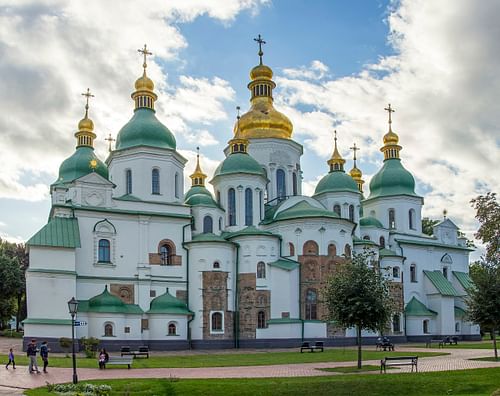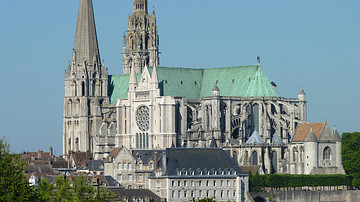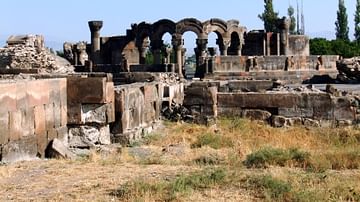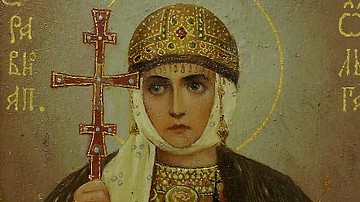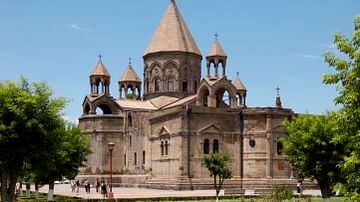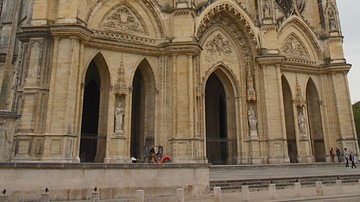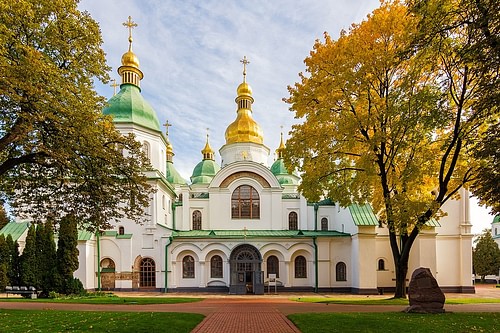
Saint Sophia Cathedral in Kyiv, Ukraine is a monument of 11th-century architecture, painting, and mosaic work. The cathedral was named after Hagia Sophia and, as the main temple of the state, played the role of its spiritual, political and cultural centre. Under the domes of Saint Sophia Cathedral, there were solemn inaugurations of the Grand Dukes, holy councils, receptions of ambassadors and the signing of political agreements. Chronicles were kept at the cathedral and the first known library in Rus was created there.
Founding
It is not known for sure who founded the cathedral; there are two common versions of the foundation of the shrine. According to Primary Chronicle, the founder of the cathedral was Duke Yaroslav the Wise of Kyiv (c. 978-1054), who built the cathedral in 1037 after his decisive victory over Pechenegs. Other sources state that the cathedral was founded by Vladimir the Great (c. 958-1015) in 1011. After the research of wall inscriptions inside the cathedral, historians assumed that it is possible the foundation of the cathedral was laid in 1011. The second theory has been accepted by both the Ukrainian government and UNESCO, which solemnly celebrated the 1000th anniversary of the cathedral in 2011.
Architecture
Even though we do not know the names of the architects, we can assume that it was built by first-class masters of the Byzantine Empire. They implemented quite common features of both Rus and Byzantine architecture into the cathedral. Amongst them are the number of domes and their shape, the increased number of naves, the distinct pyramidal shape, the disproportion between the width and length of the body of the cathedral, and striving for height.
The cathedral is built of large natural stones - granite and rose quartzite in the Byzantine technique of mixed brick-stone masonry (with brick gaskets), as a result of which two-colour strips of different textures are created on the main surface. The facades of the church were not plastered; the masonry remained open. Today, we can see the original masonry on some unplastered sections of the cathedral.
Originally, Saint Sophia Cathedral was a cross-domed church with 13 domes. The central high dome of the temple in Byzantine style was built to remind the Christ – the Head of the Church. The 12 other domes of the cathedral were associated with the apostles. The arches of the cathedral represent the heavenly gates through which the people entered this sacral place.
In the 17th century, Petro Mohyla (1597-1647) and Ivan Mazepa (1639-1709) funded the reconstruction of the cathedral and thoroughly rebuilt the upper part of Saint Sophia. For this work, an Italian architect Octaviano Mancini (c. 1580-1638) was invited. Also, the entire ensemble of the surrounding buildings of Saint Sophia was built. The building of the cathedral after the reconstruction and the surrounding constructions have differentiating features of the Cossack baroque.
Interior
Inside there are 260 square meters of mosaics and 3 thousand square meters of frescoes dating to the 11th century. Mosaics of the 11th century adorn the main parts of the cathedral – the central bath and the main altar. They are arranged in a strict order according to the heavenly hierarchy. Next to each mosaic composition, there are inscriptions in Greek explaining the imagery. The names of the mosaicists are unknown. All the mosaics of the cathedral are made on a shiny gold background and they are richly coloured. For all the colour variety of mosaics, the predominant tones are grey-white and blue in combination with purple. At the highest place of the main dome, there is a mosaic of Christ Pantocrator.
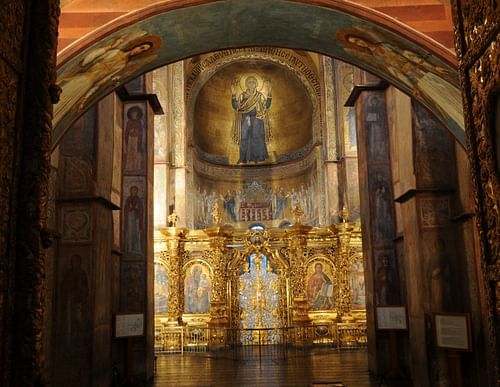
The frescoes preserved in Saint Sophia Cathedral also date back to the 11th century – they were made during the construction of the cathedral. In the 19th century, during the reconstruction of the cathedral, the frescoes were restored with oil paints. The whole ensemble of the frescoes of the cathedral was subordinated in its content to a single plan – the introduction of the recently adopted Christianity. At the same time, the painting of the main cathedral of the state was to show the greatness of Rus, its international recognition, and the role of Kyiv in the political life of Europe. Hence, a significant place is given to secular compositions. On the three walls of the central nave, opposite the main altar, a princely family portrait of the founder of the cathedral was painted and it is either the family of Duke Vladimir or his son Yaroslav.
Saint Sophia Cathedral has served as a tomb since its foundation. The necropolis of the cathedral contained burials of dukes and the higher clergy. It is also the oldest in Rus and covers a long period of history. Most of the names of those buried in Sofia’s necropolis are unknown; however, those identified burials indicate that prominent figures were laid to rest there. The most famous entombments belong to Yaroslav the Wise and Volodymyr Monomakh (1053-1125).
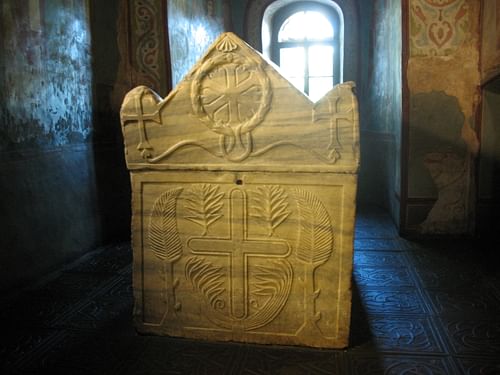
Bell Tower
The bell tower of Saint Sophia Cathedral in Kyiv is an architectural monument in the Cossack Baroque style. Its construction was funded by Ivan Mazepa in 1699. The height is 76 metres (250 ft). Initially, the bell tower was three-tiered, but in 1851-1852, it was elevated by another tier and was crowned with a wooden pear-shaped onion dome, covered with gilded copper sheets. The sculptural decor of the bell tower perfectly interacts with its architectural composition. It is decorated with various stucco ornaments, which are interwoven with plot bas-reliefs. Almost all the stucco has been preserved.
History
The Millennium-old history of the cathedral has been troubled. Saint Sophia Cathedral has survived enemy invasions, looting, partial destruction, repairs and reconstructions. The first major threat to the church was the pillaging of the city in 1169. Kyiv was captured and destroyed by Duke Andrei the Pious (c. 1111-1174) of Vladimir-Suzdal, who took all the gold items and church relics, in particular, the icon of the Blessed Virgin. The cathedral survived and was revived. Then came one of the most difficult periods of Kyivan history – the siege of the city by the hordes of Batu Khan in 1240 when the majority of the architectural structures were turned into ashes. Saint Sophia Cathedral survived again. However, looted and devastated, Saint Sophia lost its former beauty and majesty, although it remained the city's main operating church. In the next century, Cyprian (1330-1406), the Metropolitan of Kyiv, funded the repair of the cathedral. In the 15th century, Saint Sophia was looted and pillaged twice, first by Edigu Khan (1352-1419) in 1416 and second in 1482 by Menli I Giray (1445-1515). From 1497 to 1577 the cathedral was abandoned. In 1577 the cathedral was repaired and later given to the Greek-Catholic Church.
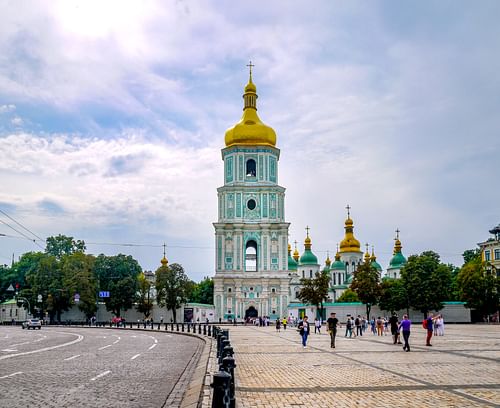
In 1633 a new dawn came for the cathedral. The cathedral became the property of the restored Orthodox Kyiv metropolitanate of the Patriarchate of Constantinople. The revival is connected with Kyiv Metropolitan Petro Mohyla, who managed to found a convent, overhaul the cathedral and decorate it. Wooden monastery buildings were built around the cathedral and the whole territory was surrounded by a high wooden fence. Petro Mohyla involved the Italian architect Octaviano Mancini in the works in the cathedral. The main building materials were brick and lime-sand mortar. Bricks were used for masonry walls, vaults, and foundations.
Later, the reconstruction was carried out by Hetman Ivan Mazepa. Construction of new stone buildings around the cathedral began. Such buildings as a bell tower, a metropolitan house, and the entire architecture ensemble of the Saint Sophia Cathedral were built. Ivan Mazepa gilded the main dome at his own expense. All these buildings and the renovated cathedral obtained traits of Cossack Baroque.
In the 20th century, Saint Sophia Cathedral played a significant role in history and faced many threats to its existence. At the beginning of the century, two important events happened there. The first is the dedication of Pavlo Skoropadsky (1873-1945) to the hetman of all Ukraine in 1918 and the proclamation of the Unity Act in 1919, which united “two Ukraines”. But soon after, the Ukrainian Peoples Republic fell and the city of Kyiv became part of the Soviet Union.
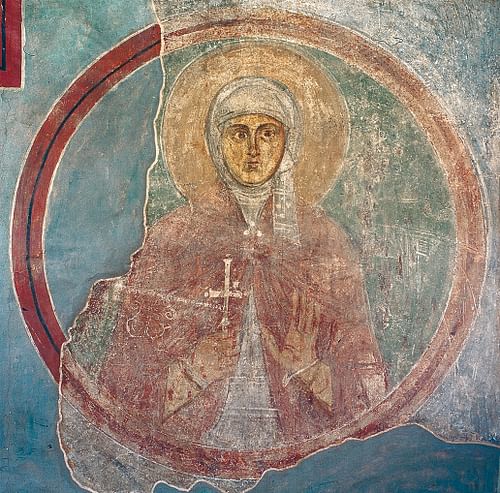
In the 1920-30s, Bolsheviks wanted to demolish the cathedral as they did to many other churches all around the USSR, but decided to save it. The territory of the Sophia Cathedral was declared a State Historical and Architectural Reserve. All gold and silver items were confiscated, the gilded iconostasis was dismantled, any gold was stripped, and the rest was burned. In 1941 when the Red Army was retreating from Kyiv, Saint Sophia was mined, but the explosion did not happen. During the Nazi occupation of Kyiv, the exhibits of the Sofia Architectural and Historical Museum were looted, and some of the expensive icons and photographic archives were taken to Germany.
In the post-war period, many reconstructions were carried out at the cathedral and surrounding buildings. Many new frescos and mosaics were discovered and research was done. In 1990, the ensemble of the Saint Sophia Cathedral was included in the UNESCO World Heritage List. Today, the cathedral is a highly popular and renowned building that attracts tourists from all around the world. The square in front of the cathedral is regularly used for celebrations of Independence Day, Christmas, Easter, and many other holidays.
